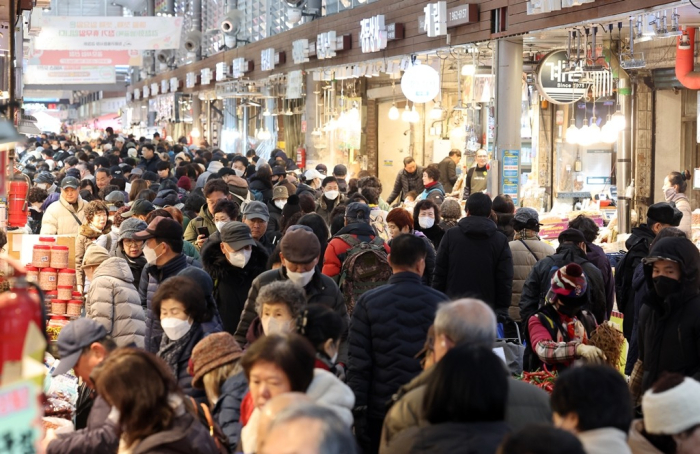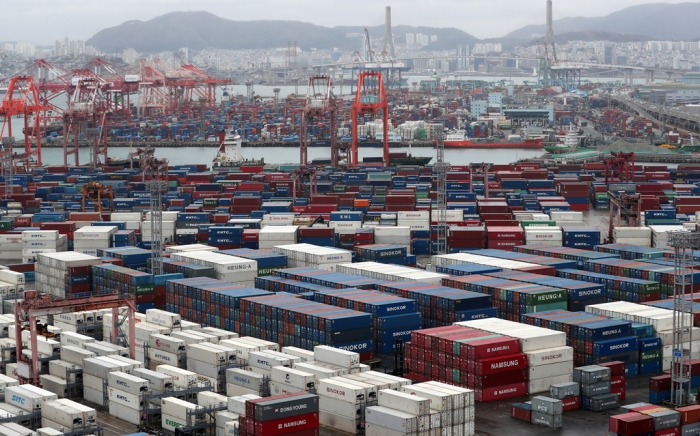Economy
S.Korea’s GNI per capita rebounds in 2023 as won stabilizes
February exports rose 4.8% on-year as overseas sales of semiconductors surge 66.7%, the largest growth since Oct. 2017
By Mar 05, 2024 (Gmt+09:00)
2
Min read
Most Read
LG Chem to sell water filter business to Glenwood PE for $692 million


Kyobo Life poised to buy Japan’s SBI Group-owned savings bank


KT&G eyes overseas M&A after rejecting activist fund's offer


StockX in merger talks with Naver’s online reseller Kream


Mirae Asset to be named Korea Post’s core real estate fund operator



South Korea’s gross national income (GNI) per capita rebounded last year as the won currency stabilized amid signs of a recovery in exports from Asia’s fourth-largest economy led by overseas sales of semiconductors.
The GNI per capita rose 2.6% to $33,745 in 2023 from the previous year when income dropped 7.4%, central bank data showed on Tuesday.
The recovery came as the South Korean won eased 1% against the dollar on average last year, according to the Bank of Korea (BOK). The local currency tumbled 11.4% versus the US unit in 2022, pushing down South Korea’s GNI per capita to a revised $32,886 from a revised record high of $35,523 in 2021.
South Korea was one of the world’s poorest countries with a GNI per capita of $57 in 1953. The income exceeded the $10,000 level in 1994, the $ 20,000 mark in 2006 and the $ 30,000 level in 2017. The GNI per capita, however, fell in 2019 and 2020 due to the US-China trade dispute and the COVID-19 pandemic.
The GNI per capita, the dollar value of a country's final income in a year divided by its population, reflects the average before-tax income of a country’s citizens.
The GDP deflator, a measure of the level of price increases of all the new, domestically produced, final goods and services in an economy in a year, rose 2.1% in 2023 from the prior year.
SLOWER GROWTH
South Korea’s economic expansion slowed in 2023 as the growth in the manufacturing and service sectors eased, central bank data showed.
The economy grew 1.4% last year, nearly half the 2.6% of the previous year. The manufacturing sector’s growth fell to 1% from 1.5%, while the service sector’s growth halved to 2.1% from 4.2%.
In the fourth quarter, the economy expanded 0.6% from the previous three months on a seasonally adjusted basis with the manufacturing sector up 1.2%. Exports, the country’s main growth driver, also rose 3.5% led by overseas sales of semiconductors, the BOK said.

Exports in February increased 4.8% to $52.4 billion from a year earlier, extending their rising streak to a fifth straight month, separate data from the Ministry of Trade, Industry and Energy showed last week.
Semiconductor exports surged 66.7%, enjoying the largest growth since October 2017. The country is home to the world’s two largest memory chipmakers – Samsung Electronics Co. and SK Hynix Inc.
Write to Jin-gyu Kang at josep@hankyung.com
Jongwoo Cheon edited this article.
More to Read
-
 EconomyS.Korea's GNI per capita falls in 2022 on foreign exchange fluctuation
EconomyS.Korea's GNI per capita falls in 2022 on foreign exchange fluctuationJan 18, 2023 (Gmt+09:00)
1 Min read -
 EconomyS.Korea lags Taiwan in GNI per capita for first time since 2002
EconomyS.Korea lags Taiwan in GNI per capita for first time since 2002Mar 07, 2023 (Gmt+09:00)
2 Min read -
 EconomyKorea GNI per capita at record on strong economic growth
EconomyKorea GNI per capita at record on strong economic growthMar 03, 2022 (Gmt+09:00)
2 Min read
Comment 0
LOG IN


